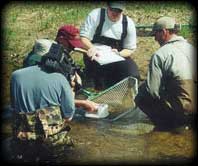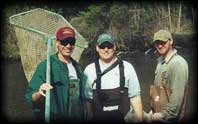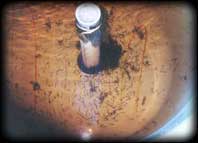2001 Lake Sturgeon Research on Black Lake
TO PHYLLIS CRIST we say, "THANK YOU for offering access of your property to set-up and monitor the temporary weir."

The purpose of the weir is for the collection of video documentation to determine the year-class of adult lake sturgeon migrating upstream to spawn. The weir consisted of fencing placed across the river, providing a 12 feet wide opening for navigation and for the sturgeon to cross over a 12 feet by 12 feet grid, in 12 inch segments. Video equipment was placed over the grid to document, date, time, length and number of sturgeon migrating up and downstream.
CMU Masters student Kregg Smith, DNR Fisheries Research Biologist Dr. Edward Baker, MSU Genetics student Pat DeHaan, and DNR assistant Tom Tryban, utilized large nets to capture the sturgeon. Data collected consisted of date, mean length, fork length, weight, girth and gender.
A small, 2-1/2 inch colored floy tag was inserted in the dorsal fin. The floy tag is an external tag used to visually identify the sturgeon as being tagged.

A PIT (Passive Integrated Transponder) tag, (size of rice) was inserted, with a syringe, behind the fourth dorsal scute. PIT tags have a 10 letter-number frequency and have a life expectancy of 100 years. An AVID Power Tracker III reader was scanned over the sturgeon/PIT tag. Researchers will utilize this information to collect data on each individual sturgeon tagged, including future recaptures.
A small dorsal fin sample was taken for DNA analysis. MSU will run molecular genetic analysis to identify parental contribution to their off-spring.

Drift Net sampling of the larvae has been done to document annual larval production. There were roughly 2,800 larvae collected and studied by Kregg Smith. The larvae were put into holding tanks and fed brine shrimp prior to transferring to Wolf Lake State Fish Hatchery to nurture.
The 4 to 8 inch fingerlings will be put back into the river this fall. They will be marked with a wire-coded tag or PIT tag, or both. A small fin sample will be taken from the fingerlings for DNA analysis.
One fundamental piece of information of critical importance for species restoration is the degree of population structuring within and among spawning areas, drainages and lake basins. In addition, information of degree of genetic differentiation among breeding populations can be used to assign individuals or groups in open lake systems to breeding sites of origin. Genotype data from spawning adults and out-migrating juveniles can be used to determine reproductive success and recruitment.
Roughly 6 of the fingerlings will remain at the hatchery for a few months to grow larger. They will then be equipped with sonic equipment for the purpose of telemetry research.
Kregg will continue his research on the lake throughout the summer. He will be netting, trawling and using set lines. He will also be electofishing this fall in search of the juveniles.
If you see Kregg out and about, give him a SALUTE… he continues to do an awesome job.
- Home Page
- Black Lake
Sturgeon Shivaree - Black Lake Watershed
- Black Lake Sturgeon Management Plan
- Committees
- Contact Us
- Directors
- Events
- Habitat Conservation
- Membership
- Newsletters
- Our History
- Photo Gallery
- Research
- Resources
- Resources for Educators
- SFT Scholarships
- Spearing Guidelines
- State Regulations
- Sturgeon Guarding
- Sturgeon Hatchery
- Sturgeon in the Classroom

